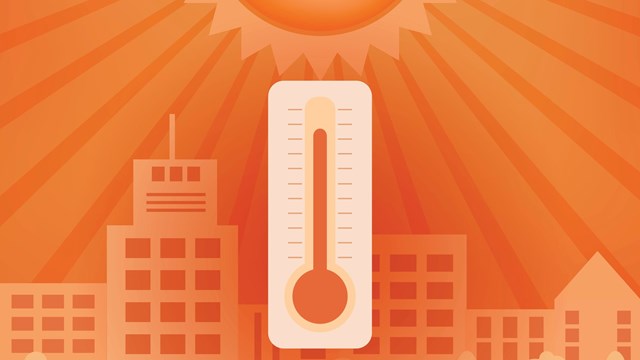
From the outside, the structure of a condo or co-op building may appear to be monolithic; just one big piece of brick and steel, punctuated with some glass here and there. That's an oversimplification, however. A multifamily building is perhaps more like a human body, with a multitude of organs and moving parts working together to keep the building healthy and vibrant. From the roof to the boiler and all points between, ensuring that systems are operating efficiently is a continual challenge.
The primary operating systems in a multifamily building include roofing, the building envelope, waterproofing, electrical, mechanical, heating, ventilation and air conditioning (HVAC), plumbing, and in some cases, elevator systems. In high-rise or multi-unit buildings especially, the association is responsible for providing many of these basic utilities to unit owners.
Climate Control
The problems that beset HVAC systems largely depend upon the type of system installed, and whether it was installed properly in the first place. “A primary problem with HVAC systems is having an improperly sized system,” says John Lillis, vice president of All Temp Heating & Air Conditioning Residential Services in Chicago. “When that happens, you have uneven temperatures, and you’ll have cycling—which is the unit running on and off frequently. That leads to deterioration of the system, and the comfort level will not be what it’s supposed to be.”
And while the size of a building might matter in terms of scale and expense, the actual approach to maintaining HVAC equipment is similar. “Annual maintenance is the key for both small and large buildings,” says Lillis. “It basically entails cleaning and checking the entire system from top to bottom to make sure it’s performing the way it should be, that way you can catch any problem before it arises.”
Experts believe that larger buildings (six stories or more) tend to have more complex systems, may require more maintenance personnel and when problems do occur, they can occur on a grand scale while small buildings tend to have less maintenance.
Clean Air
The leading reason conditioned air remains conditioned—i.e., comfortably warm or cool—and safe to breathe is dependent on the integrity of the building 'envelope,' which is designed to protect residents and the interior of the building from the elements. “The envelope is made up of the façade—the outside walls—the roof and the foundation,” according to Mitchell Frumkin, PE, RS, CGP and president of Kipcon, an engineering and consulting firm, which is headquartered in New Jersey and also has offices in Wheeling, Illinois. “It protects the building from two things; the first is water intrusion, and the second is air infiltration.” If these systems break down, it can set off a cascade of problems.
Allan Samuels is a mechanical, electrical and plumbing engineer, and managing partner with Energy Squared, an HVAC contractor based in Princeton, New Jersey that carries out work all across the country. According to Samuels, “A building needs air conditioning, but also heating and ventilation. These are critical elements. These are the biggest energy users, and as such they require a lot of maintenance.” Frumkin agrees. “Air infiltration can account for HVAC bills going up by as much as 30 percent in some cases.”
Indoor environmental systems often use water as the medium for heating and cooling, says Samuels. “The water for these systems has to be treated and maintained on a regular basis.” If it isn't, Samuels says that can lead to everything from a shortened life span of the equipment itself to health hazards such as mold grown and even Legionnaires’ disease. To prevent these issues, most systems have chemical additives automatically fed into the system every 24 hours or so.
And while some maintenance and supervision on HVAC equipment can be done by a building staff member with some basic training, Samuels says that “It varies from building to building, but in general these are specialized systems, so boards and managing agents typically use an outside company to handle the maintenance.”
While builders often tout a building's air-tightness as a sign of its energy-efficiency, lack of fresh air exchange and circulation can actually be a problem in some situations—and poorly maintained air filters can exacerbate it. Samuels recommends that air filters be inspected regularly, and have maintenance performed every three to four months. “[Filters] have to be replaced or cleaned, and all dampers checked to ensure they are operating properly,” he says.
Samuels also notes that health codes generally require that buildings' HVAC systems bring in a certain volume of outside air, so systems must be checked and optimized to make sure those standards are being met. “During the initial design of the building, the plans are scrutinized by [the municipality's] building department to ensure that the correct amount of air is being brought in, but once the system is installed, it’s up to the board to maintain it.”
According to the pros, the longevity of these systems depends on a number of objective and subjective factors. A large cast iron boiler could last 50 years, while a “typical” rooftop HVAC system might only last 15 years. “A reserve study will determine what the useful life span of a particular piece of equipment is,” says Samuels. “These systems are like a car. When you buy one, on day one it goes like a rocket and runs great. As the years go by, the performance of the car begins to decline. It's the same situation for all building systems.”
Going Up or Down?
A crucial piece of building anatomy—particularly for high-rise residents—is a working elevator. Whereas a newer elevator might go several months without a service call, older systems may require a service technician on-site on a weekly basis.
“Elevators are complex machines and critical elements within buildings,” says Patrick O’Connell, director of marketing and communications at Kone Inc., an elevator company in Naperville. “Depending on the elevator's use and design, it will require periodic maintenance to assess and ensure safe, efficient operation, including making sure that door obstruction technology is performing as expected. It’s also important to check the cleanliness of the door sills to ensure that they open and close smoothly. You should also check the integrity of the cables that carry the elevator cars.”
While other building systems might be harder to diagnosis with the naked eye, a broken elevator is plain to see—but even an otherwise operational elevator can have hidden problems. That’s why experts stress the importance of preventative maintenance and rigorous periodic inspections by a licensed professional.
“Preventative maintenance depends widely on equipment characteristics, including age and the overall use of the elevator,” says O’Connell. “We assess several factors and create a maintenance plan that best fits the particular elevator, all with the goal of minimizing service interruptions and maximizing uptime.”
Out of Sight, Out of Mind?
Many boards have management companies and/or individual superintendents overseeing these various systems, but as mentioned previously, it is often next to impossible to tell with the naked eye what is occurring inside building walls, or a large piece of mechanical equipment. A good managing agent should be able to advise the board on the maintenance requirements for these systems and whether the work can be done in-house.
“Maintenance is forced on buildings due to regulations,” says Frumkin. Kipcon Project Manager Leonard Tate adds that many issues can be easily overlooked. “With the naked eye, you won’t be able to tell if there has been water infiltration or corrosion occurring. You really need someone with experience inspecting the building envelope.”
At the end of the day, the responsibility of operating a sound, safe building falls to the board. Maintaining a close relationship with not only their manager, but with reliable, competent third party contractors is a key part of fulfilling that responsibility.
W.B. King is a freelance writer and a frequent contributor to The Chicagoland Cooperator. Staff writer Christy Smith-Sloman contributed to this article.






Leave a Comment